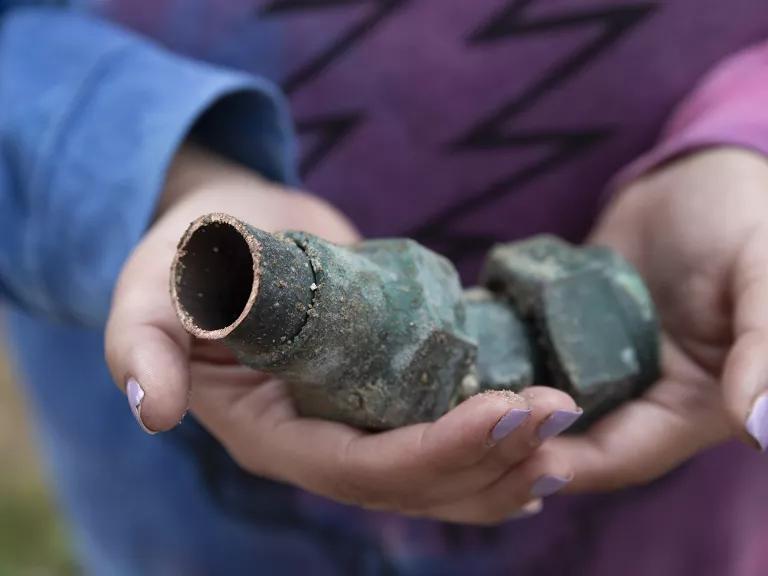California Walks Away from Hundreds of Millions of Dollars for Safe Drinking Water
The federal government has dedicated $15 billion to removing lead from our drinking water systems, but California is leaving funds on the table.

A young girl filling a glass of water from a kitchen faucet
Brian Maranan Pineda for NRDC
By walking away from hundreds of millions of dollars in federal funding, California is fumbling an important opportunity to protect communities from lead in their drinking water. The Infrastructure Investment and Jobs Act (IIJA), also known as the Bipartisan Infrastructure Law, provides states with a total of $15 billion over five years for the removal of lead from our drinking water systems, specifically the service lines connecting residences to the water system.
The funds are distributed to the states by the U.S. Environmental Protection Agency (EPA) based on their purported needs, which are reported by utilities to the EPA via the Drinking Water Infrastructure Needs Assessment Survey and Assessment. California then distributes the funds once applications for the funding have been submitted, evaluated, and ranked, which are then included in an Intended Use Plan (IUP).
The first IIJA disbursement, in 2022, was based on states’ 2015 Needs Assessments. California received more than $250 million, specifically for removing lead pipes. This year, California’s slice has been cut by about nine-tenths, down to $28 million. Why the huge reduction? Because the State Water Resources Control Board and its Division of Drinking Water (DDW) have been collecting incomplete information from utilities for years, and that incomplete information was also reported to the EPA. Unfortunately, the state’s latest draft IUP demonstrates the agency will yet again pass up the opportunity to gather complete information.
The Needs Assessment is largely based on utility inventories of service lines and those inventories should include a full accounting of the entire service line’s materials—including whether there are lead pipes, lead connectors called goosenecks or pigtails, and/or galvanized pipes that likely contain lead. We estimated that there are about 65,000 lead pipes in California, and it’s likely that lead goosenecks are more prevalent in the state. DDW also estimates there are 550,000 galvanized lines that remain in place; these lines are a potential ongoing source of lead contamination.
While the EPA has requested information about the water utilities’ entire system, including the lines under private property, California’s water board and DDW have consistently asked utilities to inventory only the public half of the system (i.e., what is under roads or public right of ways). This is despite the fact that the portion located under private property is often the longest part of the service line. The practice of not requiring full information about all potentially leaded materials has likely resulted in underreporting of California’s lead problem and has made complete reporting to the EPA almost impossible.
To make matters worse, for years, the agency has allowed utilities to only replace half of the service line. This disturbance of lead thereby causes spikes of lead in drinking water, and likely leaves sources of lead in place from the curb to the house. This has led to potential lead exposure to communities and less federal funding. As a reminder, there is no safe level of lead exposure, especially for children.
Recently, 26 groups submitted comments on the board’s draft plan for disbursing the federal funds, called the Drinking Water State Revolving Fund IUP. The state’s draft plan indicates that the agency will continue to ignore the full scope of California’s lead problem because it does not require complete information from utilities. Instead, the water board and DDW continue to stick their heads in the sand, essentially deciding that a certain amount of lead in our water system would be more palatable than standing up to water utilities and demanding the full accounting and removal of the sources of lead in our drinking water.
Based on the draft plan, it’s also safe to assume that there will continue to be dismal utility participation, and disadvantaged communities will miss out on funding. Last year, under a similar plan, only three utilities applied for lead service line replacement funding. And perhaps even more concerning is the fact that while 49 percent of this funding must be allocated to disadvantaged communities, California has yet to distribute any funds to these communities.

Part of an old service line removed during lead pipe replacement at a home
Vanessa Bly Photography
Water systems across the United States must submit lead service line inventories to the EPA by October 2024, as required by the federal Lead and Copper Rule. Between now and then, California could and should require the same from its water systems and use the free federal money to help utilities pay for their inventories. But the most recent IUP indicates that the state will miss the opportunity to disburse this federal funding.
Every person living and drinking water in California should be extremely disappointed by the state’s shortsighted and timid approach to removing lead from our drinking water. Taking a broader perspective, California’s loss is other states’ gain, as California’s unclaimed funds will be distributed to those states that have made the effort to require more complete inventories and hold their utilities accountable. So, there’s a silver lining for other states.
California state leaders must require inventories of the entire service line system and devote federal funding to these full inventories. The state should also require utilities to go back and fully fix any partial replacements that have already happened—again, using federal funds. And the state must do a better job of publicizing the availability of the federal money, focusing on systems that are serving disadvantaged communities to ensure they get the funding they need and deserve.
This blog provides general information, not legal advice. If you need legal help, please consult a lawyer in your state.






